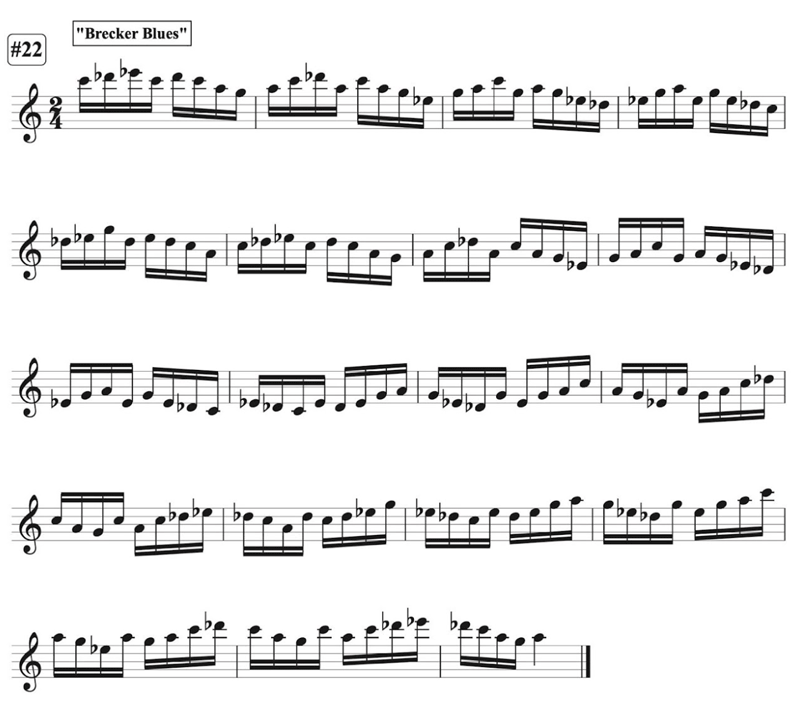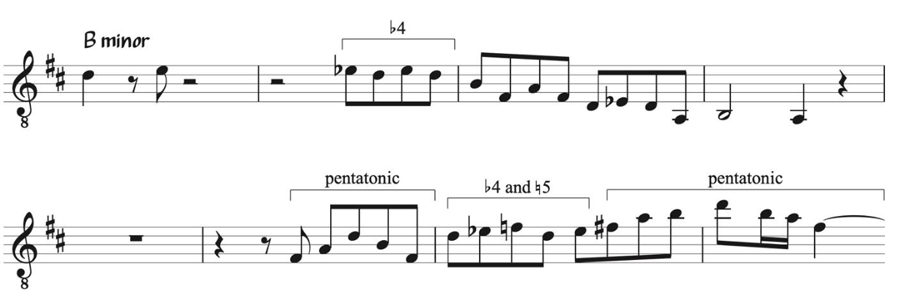Transforming a Michael Brecker Solo Into Original Patterns for Improvising

My previous article for this website explored transposition as a method of generating new ideas for improvising. With the imminent release of my book Patterns for Creative Improvisation, Volume 2, I am exploring another source of improvisational material: transcriptions. By combining transcriptions of our favorite improvised solos with some simple applications of music theory, we can generate sounds and concepts to challenge our technique, harmony, and creativity.

Click here for a more readable PDF version of “Brecker Blues”.
The above pattern (Ex. 1), is inspired by a short phrase improvised by Michael Brecker on the tune “Big Idea,” from Return of the Brecker Brothers (1992, GRP Records). A transcription of the first eight measures of this solo is presented in Example 2, without analysis.
Example 2. Michael Brecker on “Big Idea” from Return of the Brecker Brothers (1992).
This solo section is loosely in B minor, and the transcription above shows that Brecker generally conforms to this tonality using pitches from the B minor pentatonic scale (Ex. 3).
(Brecker’s solo from Example 2 starts at 1:20 in the video below.)

But what initially caught my ear and led to this phrase becoming a source for new pattern ideas are the instances in which Brecker leaves the home key and minor pentatonic scale. Example 4 applies some light analysis to the transcription, marking where Brecker departs from B minor. In measure 2 there are two instances of E-flat. In measure 7, Brecker again plays an Eb, followed by an F-natural. These pitches should clash with the prevailing harmony, as E-flat is a half step away from the minor third of B minor (D-natural) and F-natural is a half step away from the fifth of B minor (F-sharp). Instead, Brecker’s diversions from the home key create a captivating and bluesy alternative to B minor pentatonic.

Since these pitches depart from B minor, can we conceive of them as originating from another scale or mode? Example 5 juxtaposes the B minor pentatonic scale with Brecker’s included alterations of E-flat and F-natural. Six of these seven pitched are found within the B half-whole diminished scale (E-natural is not, as Example 5 shows), providing a possible origin to the sound world Brecker crafts in his solo.

Drawing on the diminished scale, I attempt to capture this sound world with a new scale that incorporates these alterations to B minor pentatonic called the “diminished pentatonic scale.” Example 6 shows this scale starting on B, the same key used in Brecker’s solo. This scale differs from a traditional minor pentatonic scale in that the perfect fourth and perfect fifth are now a diminished fourth and diminished fifth. (Remember that “diminished” can refer to a “diminished scale” as well as a “diminished” interval, when a perfect or minor interval is lowered by a half step.) With this new scale, Brecker’s phrase becomes a springboard for limitless improvisational ideas in many different contexts. The diminished fourth is enharmonically a major third, so aurally this scale has both a major and minor third. Along with the minor seventh and diminished fifth, it sounds particularly bluesy.

The B diminished pentatonic scale can be organized in any number of ways, but I like the arrangement Brecker uses in measure seven of his solo (Ex. 7).

Starting with these five pitches, my pattern (Ex. 8) completes a measure of eighth notes with three more pitches that descend through the diminished pentatonic scale—D, B, and A. The next iteration of the pattern begins in measure two on B, and on A in measure three, and on F-natural in measure four. In each measure, the pattern is shifted down one step in the diminished pentatonic scale.

In Patterns for Creative Improvisation, Volume 2, I transpose this pattern so that it uses the A diminished pentatonic scale (Ex. 9), which fits the range of the saxophone a bit better (but of course, any recipients of my book will learn the pattern in all twelve keys!).

This pattern, which I reverently title “Brecker Blues,” is also expanded to descend through the full range of the saxophone. Example 10 presents this pattern again. Halfway through, the pattern reverses direction to ascend back to its starting position. To “reverse” the pattern, I simply invert each interval—when the original pattern ascends by a step, the reverse pattern descends by a step, and vice versa (Ex. 10). Hopefully, the above analysis enlightens Brecker’s beautiful sound world, and inspires you to create your own improvisational material based on transcriptions of your favorite improvisers.

Click here for a more readable PDF version of “Brecker Blues”.





